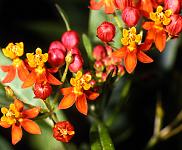Asclepias
Asclepias species ( Milkweeds ) have a wide distribution in the America and Africa
and include about 200 species of mainly perrenial herbs. The scientific name refers to the Greek god of
medicine, Asclepius, because of the supposed medicinal qualities of plants
in this genus. However, many species are poisonous and contain cardiac glysosides, the toxicity of which
may cause death in livestock or humans. Most species are not really succulent and are characterised by a
bitter thick milky sap, paired unlobed leaves and seed pods in which each flat brown seed is packed with a
silky 'parachute'. Each thread of silk is a tiny tube of cellulose. Although the silk is too short to be
spun into a thread, it was used during the 2nd World War as a filling for life-jackets. The individual
flowers are small but complex and borne in clusters. The florets have the five-fold symetry characteristic
of the Asclepiadaceae, varying in colour from greenish white or yellow to red or purple. Asclepias
flowers generally produce generous quantities of nectar, which may sometimes be seen forming droplets in
the flower centres. They are attractive to bees, butterflies and humming birds.
Asclepias species are grown as the food plant of the caterpillars of several species of
butterflies including the North American Monarch butterfly. Monarch butterflies, Danaus plexippus,
are noted for their larvae accumulating cardiac glycosides contained in the milkweed plants upon which they
feed, without toxicity to the larvae or the butterflies. This provides a chemical defense for the larvae,
the pupae, and the adult butterflies, which are consequently unpalatable to birds, rapidly eliciting an
avoidance reaction after injestion of even a single individual.
Several Asclepias species are worth growing for their unusual flowers or decorative seed pods. Some non-succulent frost-hardy Asclepias species are suitable for use as garden plants and will attract butterflies into the garden. However, in warmer countries species of Asclepias have become serious weeds.
A. syriaca the common milkweed has a poisonous milky sap, but its toxic properties are destroyed by boiling, and the young shoots, tender top leaves, flower buds, and hard, unripe seed pods can be boiled (with several changes of water) and eaten. A. syrica has been used as an alternative herbal remedy to Asclepias tuberosa (see below).
 |
Left: Asclepias tuberosa ( Butterfly weed ) has a brilliant orange flower which atracts butterflies and is one of the few species without a milky sap. It grows in dry soils in North America and Mexico. The brilliant colors of the flowers attract butterflies. One of the common names for Asclepias tuberosa is pleurisy root. The powdered roots have been used in Europe and the USA as a herbal remedy to treat lung and throat ailments, asthma and typhus fever, as the powder or an infusion is said to relieve cough and pain. |
Cultivation
Many Asclepias species can be grown in the UK as 'patio plants' using similar cultural conditions to fuchsias. A free-draining compost is suitable and suits both non-succulent and the few succulent species. The non-succulent species require plenty of water and fertiliser in hot weather and should, like fuchsias, not be allowed to dry out. Asclepias grow best in warm conditions, but may be overwintered at a minimum of 15oC. A large plant can be pruned in the Autumn and any die-back removed in the Spring.
In a sunny position Asclepias are free-flowering during the late summer and, if visited by bees and other insects, will produce seed pods freely. The seeds are wind-distributed and are packaged in the pods with large quantities of silk 'parachutes'. The seeds may be stored at 4oC and are easy to germinate as an insurance against losing plants during the winter.
Asclepias Picture Gallery
|
All photographs by R.J. Hodgkiss. Click on pictures to load full size image. |
 |
 |
 |
 |
Asclepias asperula Antelope Horns - a widely-distributed roadside plant.
Left: By the Ruby road, Coronado National Forest, Arizona. May 1997
Centre and right: In grassland at La Grange, Texas. April 1990 |
Asclepias tuberosa a colourful Mexican native grown in the UK. August 1996 |
 |
 |
 |
 |
 |
Asclepias erosa Desert Milkweed
Left: Anza-Borega Park, California. May 1995. Center and right: Chloride, Arizona. May 1997.
|











